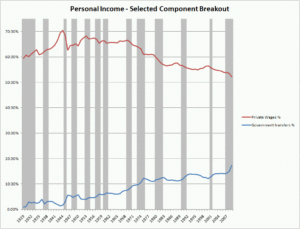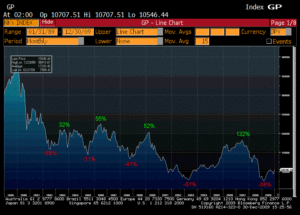The S&P 500 peaked this year on May 2nd at 1371 (intraday). The current selloff began on July 7th just slightly lower at 1356 (again, intraday). From the close on July 7th through today’s close (August 8th), the S&P 500 (as measured by the SPDR S&P 500 ETF)(1) was down 17.20% on a total return basis to 1119.
While the media has recently been filled with stories fomenting panic (about the European debt crisis, the recent US debt-ceiling political argument, and now S&P’s lowering of the US’s credit rating) and suggesting all sorts of portfolio strategies, the time to prepare for increased volatility and lower equity prices was long ago. These crises did not appear out of thin air and are not really crises in and of themselves. Rather, they are symptoms of underlying issues that have been building for some time, in plain sight. The Fed was trying to trick investors with zero percent interest rates into ignoring the problems, but eventually that had to give.
We have long been advocating portfolios built primarily around higher quality investments and reserving some cash or “dry powder” for a time when securities would likely sell at better values. Our rationale was based on the following:
- Broad equity market valuations were and are too high. We discussed a basic methodology for valuing broad markets in detail in our fourth quarter 2009 letter when the S&P 500 was also in the mid-1100s.
- Developed market sovereign debt has reached unsustainable levels relative to GDP which will likely lead to increased volatility and inflation (though deflation is a potential too). We discussed the issues of sovereign risk in our first quarter 2010 letter.
- The US economy has been supported by fiscal and monetary stimulus and will atrophy when the steroids are eventually removed. Our first quarter 2011 letter tells this story in pictures.
While the last month is merely a short battle in a long war, we are pleased that our typical equity (or “risk”) account’s losses were limited to 10.65%(2) during this period; only 62% of the S&P 500’s 17.20% loss. An important element to increasing long-term compounded growth is to minimize drawdowns. Our equity portfolios have behaved as designed.
1. The SPDR S&P 500 ETF (“SPY ETF”) is used for comparing performance on a relative basis. There are significant differences between the SPY ETF and our accounts, which do not invest in all or necessarily any of the securities that comprise the SPY ETF.
2. This is an intra-month estimate reflective of one account invested in our model and is not representative of all clients. While clients were invested in the same securities, this performance does not reflect a composite return.The return presented is net of all adviser fees and includes the reinvestment of dividends and income. Clients may also incur other transactions costs such as brokerage commissions, custodial costs, and other expenses. For the most recent performance, please visit www.greyowlcapital.com or call us at 703-459-9400.
THE RETURN SHOWN REPRESENTS PAST PERFORMANCE AND IS NO GUARANTEE OF FUTURE RESULTS. NO CURRENT OR PROSPECTIVE CLIENT SHOULD ASSUME THAT FUTURE PERFORMANCE RESULTS WILL BE PROFITABLE OR EQUAL THE PERFORMANCE PRESENTED HEREIN.


